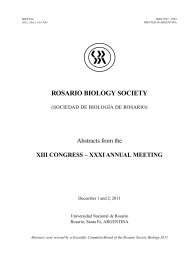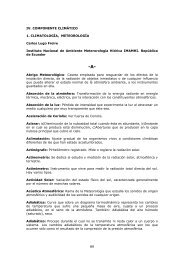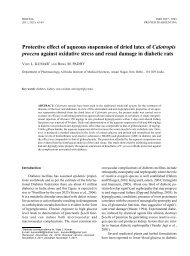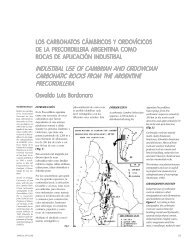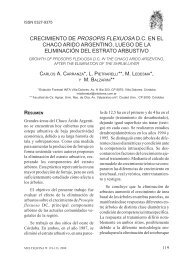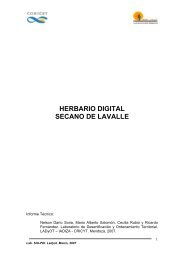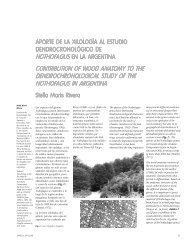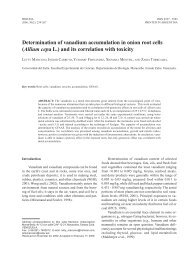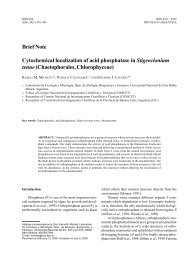XXII Annual Scientific Meeting, Tucuman Biology Society ...
XXII Annual Scientific Meeting, Tucuman Biology Society ...
XXII Annual Scientific Meeting, Tucuman Biology Society ...
You also want an ePaper? Increase the reach of your titles
YUMPU automatically turns print PDFs into web optimized ePapers that Google loves.
196 ABSTRACTS<br />
121.<br />
ISOLATION OF Candida SPECIES FROM DIFFERENT<br />
NICHES OF ORAL CAVITY IN PERIODONTAL PATIENTS,<br />
AND ITS RELATIONSHIP WITH SYSTEMIC CONDITIONS<br />
López Rubio AC 1 , Garbero I 2 , Testa MM 1 , Cárdenas IL 1 .<br />
1 Microbiology Department. 2 Preventive Dentistry. Faculty of<br />
Dentistry. National University of <strong>Tucuman</strong>.<br />
E-mail: carolopezrubio@hotmail.com<br />
The aim of this work is to determine the prevalence of Candida<br />
species in different ecological niches of the mouth: periodontal<br />
pockets, saliva and oral mucosa, in periodontitis patients with and<br />
without systemic diseases. Thirthy-three periodontitis patients between<br />
19 and 76 years old were studied. Samples used for<br />
micological diagnosis were: subgingival plaque, mucosa of palate,<br />
cheek and tongue, and saliva. They were seeded in CRHOMagar<br />
for colony counts and species identification. From the total of patients,<br />
4 had diabetes, 1 had a cardiovascular disease, 4 were hypertensive,<br />
and 7 were smokers. Candida was isolated from tongue<br />
in 45.5% of patients, from saliva in 39.4%, from cheek mucosa in<br />
24.2%, from palate in 21.2% and from subgingival plaque in 18.2%.<br />
C. albicans was the most prevalent species in all ecological niches<br />
and the only species identified in periodontal pockets. C. krusei was<br />
isolated from saliva, tongue and palate; C. tropicalis in saliva and<br />
tongue, and C. parapsilosis only in tongue. Significant statistical<br />
differences (p= 0.004) between smokers and no smokers related with<br />
Candida isolation from saliva. There were not significant statistical<br />
differences between having or not other systemic diseases, except<br />
when diabetic condition and smoking were considered together<br />
(p=0.01). Tongue is the ecological niche with higher diversity of<br />
Candida species, being the most prevalent C. albicans, and it was<br />
the only species isolated form periodontal pockets. Diabetic patients<br />
who are smokers had more risk to be colonized by yeast.<br />
Supported by CIUNT.<br />
122.<br />
KNOWLEDGE OF GRADE AND POST GRADE DENTISTRY<br />
STUDENTS OF DENTAL ATTENTION OF PREGNANT<br />
WOMEN<br />
Garbero I 1 , López Rubio AC 2 , Navarro A 1 , Gutiérrez de Ferro MI 2 ,<br />
Cárdenas IL 2 .<br />
1 Microbiology Department. 2 Preventive Dentistry. Faculty of<br />
Dentistry. National University of <strong>Tucuman</strong>.<br />
E-mail: carolopezrubio@hotmail.com<br />
The aim of this work was to evaluate grade and postgrade students’<br />
knowledge about dental practices in pregnant women. A qualitative-quantitative<br />
research was realized using an auto-administered<br />
questionnaire in a group of 28 dentistry students and 14 residents.<br />
The questionnaire considered: knowledge of the clinical pregnancy<br />
history, derivation to dental control during pregnancy control (PNC),<br />
aspect of mouth health during the pregnancy, dental treatments that<br />
can be realized without risk for the fetus, best moments for clinical<br />
therapy, etc. Mean age of students was 24.7 ± 2.7 years old, 6 were<br />
males and 36 women. 69% does not know the clinical perinatal<br />
history, 59.5% knows derivation norms for dental surveillance during<br />
PNC, and 73.8% thought that written authorization of physician<br />
was need for any dental practice. 71.4% of the students considered<br />
gingival status as the main problem. About the main reason<br />
of dental complications, 90.5% of the students considered poor oral<br />
hygiene, 81% hormonal changes in pregnancy and 54.8% vomits<br />
of the first quarter. 88.1% considered that basic periodontal therapy<br />
does not represent risk for the fetus, and 47.6% believed that the<br />
second quarter was better for therapyThere were no significant<br />
differences in knowledges between grade and post-grade students.<br />
Knowledge demonstrated by dentistry students and residents about<br />
dental practices during pregnancy were insufficient.<br />
Supported by CIUNT.<br />
BIOCELL 30(1), 2006<br />
123.<br />
RELATIONSHIP AMONG Candida SPECIES ISOLATED<br />
FROM ORAL CAVITY WITH CARIES AND PERIODONTAL<br />
DISEASE<br />
Lopez Rubio AC 1 , Garbero I 2 , Testa MM 1 , Cardenas IL 1 .<br />
1 Microbiology Department. 2 Preventive Dentistry. Faculty of<br />
Dentistry. National University of <strong>Tucuman</strong>.<br />
E-mail: carolopezrubio@hotmail.com<br />
It has been suggested that the use of broad spectrum antibiotics<br />
can promote superinfections with yeast in periodontal pockets.<br />
Candida albicans is considered among dental caries associated<br />
microorganisms. The aim of this work was to establish the relationship<br />
among Candida isolation and caries and periodontal disease,<br />
and to describe species distribution in both groups. Thirtythree<br />
patients of the Faculty of Dentistry, with periodontal disease<br />
(PD) and the same number with dental caries (C) were selected. A<br />
clinical examination recording the following parameters were done:<br />
sugar intake, plaque index and CPOD (number of teeth with caries,<br />
lost and obturated). At the same time saliva simples for micological<br />
studies were collected. Samples were seeded in CRHOMagar for<br />
colony counts and species identification. Plaque Index mean was:<br />
1.37 ± 0.67 (C) and 1.66 ± 0.60 (PD), (p>0,05). Saliva CFU/ml<br />
mean were: 481.33 ± 962.45 (C) and 249.70 ± 896.64 (PD) (p>0,05).<br />
In the 66.7% (C) and 63.6% (PD) yeast species was not identified.<br />
24.2% (C) and 30.3% (PD) were C. albicans and 3% of each group<br />
had C. tropicalis. C. krusei were isolated in only one periodontitis<br />
patient and C. parapsilosis in two caries patients. There was not<br />
difference in Candida isolation between the two oral diseases. C.<br />
albicans was the species most frequently isolated in the two groups.<br />
Supported by CIUNT.<br />
124.<br />
RELATIONSHIP BETWEEN PROSTAGLANDIN E 2 AND<br />
ANTIGEN PRESENTING CELLS IN AN ANTITUMORAL<br />
IMMUNOTHERAPY EXPERIMENTAL MODEL<br />
Valdez JC, Gobbato N, Mercau GT, Huaman M, Mercau G.<br />
Facultad de Medicina, Cátedra de Histología. Av. Roca 2100,<br />
(4000) Tucumán. E-mail: pumavaldez@hotmail.com<br />
Intrroduction: Dendritic cells (DC) are of transcendental significance<br />
in the induction of antitumoral response. Prostaglandin E2<br />
(PGE 2 ), and chemotherapic agents can inhibit the immune response.<br />
We analyze the relationship between splenic and plasmatic PGE 2 ,<br />
with the generation of splenic DC in the context of mice breast<br />
cancer treated with chemotherapy and immunostimulation.<br />
Material and methods: 12 Balb/c mice with M3 breast cancer<br />
where separated in four groups: Mice in Group D were inoculated<br />
with IV doxorubicin (D) 0.2 ml (150 ug /ml); Group V received 0,1<br />
ml of IM Ribovac Vaccine (2,5 ug of bacterian RNA + 280 mg of<br />
proteoglycans/ml); group DV received D and after 24 h Ribovac<br />
Vaccine , while group T served as control. PGE 2 concentration and<br />
the presence of DC were determined.<br />
Results: The concentration of PGE 2 was significantly higher in<br />
group D (460±57 pg/ml) and D+V (480±67 pg/ml) p < 0,05. The<br />
percentage of DC was also higher in group V (28±2,9) when compared<br />
with T (18±2,2 p



